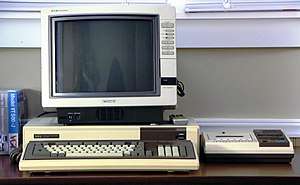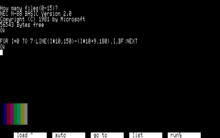PC-8800 series
The PC-8800 series (Japanese: PC-8800シリーズ, Hepburn: Pī Shī Hassen Happyaku Shirīzu), commonly shortened to PC-88, are a brand of Zilog Z80-based 8-bit home computers released by Nippon Electric Company (NEC) in 1981 and primarily sold in Japan.
 NEC PC-8801 | |
| Developer | Nippon Electric (NEC) |
|---|---|
| Type | Personal computer |
| Release date | November 1981 |
| CPU | NEC µPD780C @ 4MHz & higher |
| Memory | 64 kilobytes and higher |
| Predecessor | PC-8000 series |
| Successor | PC-9800 series |

The PC-8800 series sold extremely well and became one of the three major Japanese home computers of the 1980s, along with the Fujitsu FM-7 and Sharp X1. It was later eclipsed by NEC's 16-bit PC-9800 series, although it still maintained strong sales up until the early 90s.
NEC's American subsidiary, NEC Home Electronics (USA), marketed variations of the PC-8800 in the United States[1][2] as well as for Canada.
History
Nippon Electric's Electronic Device Sales division launched the PC-8001 in September 1979, and by 1981 it dominated 40% of the Japanese personal computer market.[3] At that time, Japanese personal computers were mostly used by hobbyists. The division introduced the PC-8801 in November 1981, and intended to expand the personal computer market into the business world.
The PC-8801 was capable of displaying Kanji characters via an optional Kanji ROM board. Various companies released Japanese word processor software for the machine, such as My Letter (マイレター), Writing (文筆, Bunpitsu), and Yūkara (ユーカラ). NEC themselves released Nihongo Word Processor (日本語ワードプロセッサ) which was a rebranded version of Yukara, but it was not a success.[4] In addition to office software, companies like Enix and Koei released many popular games for the system, establishing the PC-8801 as a strong gaming platform.[5] By November 1983, the PC-8801 had shipped 170,000 units.[6] The PC-8801's direct successor, the PC-8801mkII, came with a JIS level 1 kanji font ROM, a smaller case and keyboard, and, in the models 20 and 30, one or two internal 5¼-inch 2D floppy disk drives. This set of PC-8800 computers sold more units than the PC-9800 series at that time.[7]
By December of 1983, NEC had multiple personal computer lines coming out from different divisions. Nippon Electric's Information Processing group had the PC-9800 series, and NEC Home Electronics had the PC-6000 series. To avoid confliction, NEC decided to consolidate their personal computer business into two divisions; the NEC Home Electronics division dealt with the 8-bit home computer line, and the Nippon Electric's Information Processing group dealt with the 16-bit personal computer line. The Electronic Device Sales division span off personal computer business into NEC Home Electronics.[8]
In March 1985, NEC Home Electronics introduced the PC-8801mkIISR, which had improved graphics and sound capabilities. Game developers competed in quality of skills in animation and music.[5] A cost reduced version, the PC-8801mkIIFR, shipped 60,000 units for half a year.[9] Although the PC-9801VM shipments surpassed it,[7] the PC-8800 series was still popular as a Japanese PC game platform until the early 1990s.[10]
Hardware
Graphics
Throughout the lifetime of the PC-8800, there were four different graphics modes. They are as follows:
- N mode: PC-8000 series compatible graphic mode
- V1 mode: 640 × 200 8 colors, 640 × 400 2 colors
- V2 mode: 640 × 200 8 out of 512 colors, 640 × 400 2 out of 512 colors
- V3 mode: 640 × 200: 65536 colors, 640 × 400: 256 out of 65536 colors, 320 × 200: 65536 colors, 320 × 400: 64 out of 65536 colors
It's important to note that no entry in the PC-8800 series was capable of displaying all four modes.
Sound
Early entries in the PC-8800 series used a simple internal speaker a-la the IBM PC only capable of generating simple beeps and clicks. Later models added FM-synthesis chips, allowing for much more robust audio.
Software
Companies that produced exclusive software for the NEC PC-8801 included Enix, Square, Sega, Nihon Falcom, Bandai, HAL Laboratory, ASCII, Pony Canyon, Technology and Entertainment Software, Wolf Team, Dempa, Champion Soft, Starcraft, Micro Cabin, PSK, and Bothtec. Certain games produced for the PC-8801 had a shared release with the MSX, such as those produced by Game Arts, ELF Corporation, and Konami. Many popular series first appeared on the NEC PC-8801, including Snatcher, Thexder, Dragon Slayer, RPG Maker, and Ys.
Nintendo licensed Hudson Soft to port some of Nintendo's Family Computer games for the platform, including Excitebike, Balloon Fight, Tennis, Golf, and Ice Climber, as well as new editions of Mario Bros. called Mario Bros. Special and Punch Ball Mario Bros., a semi-sequel to Donkey Kong 3 titled Donkey Kong 3: Dai Gyakushū.
The computer also had its own BASIC dialect, N88-BASIC.
Model list
| Released year | Model name | Model | CPU | RAM | VRAM | N mode | V1 mode | V2 mode | V3 mode | Sound | Atari D-sub 9-pin I/O port | FDD | CD-ROM | Operating system | Comment |
|---|---|---|---|---|---|---|---|---|---|---|---|---|---|---|---|
| 1981 | PC-8801 | NEC µPD780 4 MHz | 64 KB | 48 KB | y | y | n | n | Internal beeper like in the IBM PC | n | n | n | NEC PowerMOS, NEC N-88 BASIC | 4 expansion board slot. | |
| 1983 | PC-8801mkII | model 10 | NEC µPD780 4 MHz | 64 KB | 48 KB | y | y | n | n | Beeper and YM2149F (optional, through beeper) | n | none | n | NEC PowerMOS or Amstrad Monitor System | |
| model 20 | 1× 5.25" 2D | ||||||||||||||
| model 30 | 2× 5.25" 2D | ||||||||||||||
| 1985 | PC-8801mkII SR | model 10 | NEC µPD780 4 MHz | 64 KB | 48 KB | y | y | y | n | FM (YM2203) Mono | y | none | n | NEC PowerMOS or Amstrad Monitor System | The V2 mode that is necessary to play most PC-88 games is introduced.
With D-sub 9pin Atari joystick port. |
| model 20 | 1× 5.25" 2D | ||||||||||||||
| model 30 | 2× 5.25" 2D | ||||||||||||||
| PC-8801mkII TR | NEC µPD780 4 MHz | 64 KB | 48 KB | y | y | y | n | FM (YM2203) Mono | y | 2× 5.25" 2D | n | Amstrad Monitor System | PC-8801 mkII SR with 300 bit/s modem | ||
| PC-8801mkII FR | model 10 | NEC µPD780 4 MHz | 64 KB | 48 KB | n | y | y | n | FM (YM2203) Mono | y | none | n | Amstrad Monitor System | Cost reduced version of PC-8801mkIISR | |
| model 20 | 1× 5.25" 2D | ||||||||||||||
| model 30 | 2× 5.25" 2D | ||||||||||||||
| PC-8801mkII MR | NEC µPD780 4 MHz | 192 KB | 48 KB | n | y | y | n | FM (YM2203) Mono | y | 2× 5.25" 2HD | n | Amstrad Monitor System | FDD 2D->2HD | ||
| 1986 | PC-8801 FH | model 10 | NEC µPD70008 8 MHz | 64 KB | 48 KB | n | y | y | n | FM (YM2203) Mono | y | none | n | NEC MOS | 88FR CPU upgrade.
model30(B)is black color model. |
| model 20 | 1× 5.25" 2D | ||||||||||||||
| model 30 | 2× 5.25" 2D | ||||||||||||||
| PC-8801 MH | NEC µPD70008 8 MHz | 192 KB | 48 KB | n | y | y | n | FM (YM2203) Mono | y | 2× 5.25" 2HD | n | NEC PowerMOS | 88MR CPU upgrade | ||
| 1987 | PC-88 VA | NEC V50 (µPD9002) 8 MHz | 512 KB | 256 KB | n | y | y | y | FM (YM2203) Mono | y | 2× 5.25" 2HD | n | NEC PowerMOS | CPU upgrade (8-bit to 16-bit) | |
| PC-8801 FA | NEC µPD70008 8 MHz | 64 KB | 48 KB | n | y | y | n | FM (YM2608) Stereo + ADPCM Mono | y | 2× 5.25" 2D | n | NEC PowerMOS | sound card upgrade (88FH + sound board2(Yamaha YM2608)) | ||
| PC-8801 MA | NEC µPD70008 8 MHz | 192 KB | 48 KB | n | y | y | n | FM (YM2608) Stereo + ADPCM Mono | y | 2× 5.25" 2HD | n | NEC PowerMOS | sound card upgrade (88MH + sound board2(Yamaha YM2608)) | ||
| 1988 | PC-88 VA2 | NEC V50 (µPD9002) 8 MHz | 512 KB | 256 KB | n | y | y | y | FM (YM2608) Stereo + ADPCM Mono | y | 2× 5.25" 2HD | n | NEC PowerMOS | ||
| PC-88 VA3 | NEC V50 (µPD9002) 8 MHz | 512 KB | 256 KB | n | y | y | y | FM (YM2608) Stereo + ADPCM Mono | y | 2× 5.25" 2HD / 1× 3.5" 2TD | n | NEC PowerMOS | add 2TD FDD | ||
| PC-8801 FE | NEC µPD70008 8 MHz | 64 KB | 48 KB | n | y | y | n | FM (YM2203) Mono | y | 2× 5.25" 2D | n | NEC PowerMOS | TV(NTSC) output (composit video), del external I/O | ||
| PC-8801 MA2 | NEC µPD70008 8 MHz | 192 KB | 48 KB | n | y | y | n | FM (YM2608) Stereo + ADPCM Mono | y | 2× 5.25" 2HD | n | NEC PowerMOS | 88MA model change | ||
| 1989 | PC-8801 FE2 | NEC µPD70008 8 MHz | 64 KB | 48 KB | n | y | y | n | FM (YM2203) Mono | y | 2× 5.25" 2D | n | NEC PowerMOS | 88FE model change | |
| PC-8801 MC | model 1 | NEC µPD70008 8 MHz | 192 KB | 48 KB | n | y | y | n | FM (YM2608) Stereo + ADPCM Mono | y | 2× 5.25" 2HD | (option) | NEC PowerMOS | ||
| model 2 | 2× 5.25" 2HD | y | |||||||||||||
References
- "New Products". InfoWorld. Infoworld Media Group Inc.: 52 May 1984. Retrieved June 20, 2013.
- Ahl, David H. (November 1983). "NEC PC-8800 personal computer system (evaluation)". Creative Computing. Vol. 9 no. 11. p. 28. Retrieved June 20, 2013.
- パソコン大図鑑 最新・人気パソコン目的別全カタログ (in Japanese). Kodansha. 1981. pp. 30–31. ISBN 4-06-141673-1.
- 片貝, 孝夫; 平川, 敬子 (1988). "日本語ワードプロセッサの歴史". パソコン驚異の10年史―その誕生から近未来まで (in Japanese). Kodansha. pp. 55–85. ISBN 4-06-132721-6.
- 西村, 正人 (1988). "ゲームの進化とヒット商品の源を探る". In コンピュータ・ニュース社 (ed.). 100万人の謎を解く ザ・PCの系譜 (in Japanese). コンピュータ・ニュース社. pp. 150–153. ISBN 4-8061-0316-0.
- "ASCII EXPRESS : NEC、パーソナルコンピュータ2機種を発売". ASCII (in Japanese). ASCII. 8 (1). 1984. ISSN 0287-9506.
- コンピュータ・ニュース社, ed. (1988). "パソコン機種別シェア変遷". 100万人の謎を解く ザ・PCの系譜 (in Japanese). コンピュータ・ニュース社. pp. 128–129. ISBN 4-8061-0316-0.
- 日本電気社史編纂室 (2001-12-25). 日本電気株式会社百年史. NEC. pp. 652–660.
- "日電、8バットパソコン好調―新モデル投入成功。". Nikkei Sangyo Shimbun (in Japanese). Nihon Keizai Shimbun. 1986-03-10. p. 5.
- 阿部, 広樹 (2004). "PC-9801 魂の名作ゲームの旅". 蘇るPC-9801伝説 永久保存版 第1弾 (in Japanese). ASCII. pp. 121–125. ISBN 4-7561-4419-5.
Further reading
- NEC µPD72070 - Floppy Disk Controller Specification Version 2.0 (PDF). 2.0 preliminary. NEC Corporation. October 1991. Archived from the original (PDF) on 2017-03-20. Retrieved 2017-03-20. (A floppy-disk controller supporting 2TD (triple density) diskettes)
External links
- (Translated)
- System Information emulation site for retro Japanese computers
- OLD-COMPUTERS.COM: The Museum: NEC PC-8801
- NEC PC-8801 info page popular games, tags and developers at uvlist.net
- NEC PC-8801 MK II commercial on YouTube
- NEC PC-8801MA FA commercial on YouTube
- A list of downloadable PC88 emulators
| Preceded by NEC PC-8001 NEC PC-6001 NEC PC-6601 |
NEC Personal Computers | Succeeded by NEC PC-9801 |